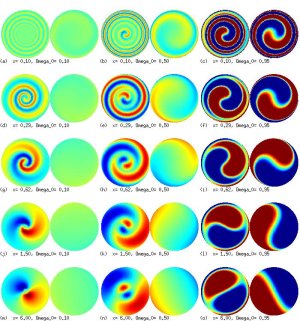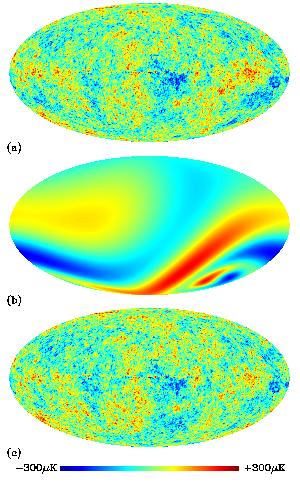 |
|
Fig. 1: Examples of CMB anisotropy patterns
induced by Bianchi models of different parameters.
Each plot shows the full sky in orthographic
projection.
|
 |
 |
|
Fig. 2: (a) shows the WMAP data, namely the
small fluctuations in the CMB over the full sky in a
Mollweid projection. (b) shows the best correlated
Bianchi model (enhanced by a factor of 4). (c)
the WMAP data corrected for the Bianchi component.
|
|  |
Since the Copernican Revolution removed humanity from the center of
the Universe, two of the most fundamental principles guiding
cosmologists have been the principles of cosmological homogeneity (or
the  Copernican
Principle) and of cosmological Copernican
Principle) and of cosmological  isotropy.
Observations show that these approximately hold true in the region of
space we can observe, but new data from the
Wilkinson Microwave Anisotropy Probe yield provocative
indications that the principle of isotropy may need to be re-examined. isotropy.
Observations show that these approximately hold true in the region of
space we can observe, but new data from the
Wilkinson Microwave Anisotropy Probe yield provocative
indications that the principle of isotropy may need to be re-examined.
The  Cosmic
Microwave Background radiation is one of the cleanest probes
available for studying the large scale structure of the Universe.
According to the Cosmic
Microwave Background radiation is one of the cleanest probes
available for studying the large scale structure of the Universe.
According to the  Big Bang
picture, the CMB originated at the moment when the expanding Universe
first became cool enough for the plasma of free electrons and protons
to form neutral hydrogen and thus to become transparent to photons -
the so-called recombination epoch - which happened when the universe
was only a few hundred thousand years old. If the Universe were
exactly homogeneous and isotropic, the CMB would be exactly the
same in every direction on the sky - but then there would be no
galaxies, stars, planets, or cosmologists! The small inhomogeneities
which eventually formed into these objects are also present in the
CMB, where they are seen as small fluctuations in temperature about a
mean value of 2.725 K. Statistically speaking, these
fluctuations should be uniformly distributed over the sky if the
Universe is isotropic, and to a large degree, they are. Big Bang
picture, the CMB originated at the moment when the expanding Universe
first became cool enough for the plasma of free electrons and protons
to form neutral hydrogen and thus to become transparent to photons -
the so-called recombination epoch - which happened when the universe
was only a few hundred thousand years old. If the Universe were
exactly homogeneous and isotropic, the CMB would be exactly the
same in every direction on the sky - but then there would be no
galaxies, stars, planets, or cosmologists! The small inhomogeneities
which eventually formed into these objects are also present in the
CMB, where they are seen as small fluctuations in temperature about a
mean value of 2.725 K. Statistically speaking, these
fluctuations should be uniformly distributed over the sky if the
Universe is isotropic, and to a large degree, they are.
While the data are generally considered to be in very good agreement
with the standard view, they contain anomalies on large angular scales
that indicate there may be a preferred direction to the universe. In
particular,  Eriksen
et al. have shown that the fluctuations show more power in
one hemisphere than in the other, for a specifically determined
coordinate frame. Motivated by this result, A. J. Banday and
T. R. Jaffe of the MPA, along with collaborators H. K. Eriksen and
F. K. Hansen in Oslo, Norway, and K. M. Górski in Pasadena,
USA, have investigated a specific class of cosmological models which
are homogeneous, but admit anisotropy. Eriksen
et al. have shown that the fluctuations show more power in
one hemisphere than in the other, for a specifically determined
coordinate frame. Motivated by this result, A. J. Banday and
T. R. Jaffe of the MPA, along with collaborators H. K. Eriksen and
F. K. Hansen in Oslo, Norway, and K. M. Górski in Pasadena,
USA, have investigated a specific class of cosmological models which
are homogeneous, but admit anisotropy.
Homogeneous models that include shear (anisotropic expansion) and
vorticity (global rotation) are known as  Bianchi
type VIIh models. CMB photons propagate
along Bianchi
type VIIh models. CMB photons propagate
along  geodesics that are
rotating about the symmetry axis and "stretched" (or redshifted) due
to the shear expansion. The radiation will then appear hotter or
colder depending on the particular path the photons have taken,
resulting in an additional anisotropy in the observed CMB in the form
of a spiral pattern (see Figure 1 for examples). geodesics that are
rotating about the symmetry axis and "stretched" (or redshifted) due
to the shear expansion. The radiation will then appear hotter or
colder depending on the particular path the photons have taken,
resulting in an additional anisotropy in the observed CMB in the form
of a spiral pattern (see Figure 1 for examples).
The researchers have compared these models to the data and  shown that the
asymmetry may be due to a combination of shear (along a particular
axis) and vorticity (about that axis). The data and the matching
Bianchi model are shown in Figure 2 (a) and (b) respectively. If this
anisotropic Bianchi component is removed from the CMB data (Figure 2
(c)), the power asymmetry and several related statistical anomalies
are corrected. shown that the
asymmetry may be due to a combination of shear (along a particular
axis) and vorticity (about that axis). The data and the matching
Bianchi model are shown in Figure 2 (a) and (b) respectively. If this
anisotropic Bianchi component is removed from the CMB data (Figure 2
(c)), the power asymmetry and several related statistical anomalies
are corrected.
Unfortunately, such a model is inconsistent with both the theory of  inflation
and with the measured total energy density of the Universe. However,
the researchers stress that a pragmatic approach should be taken in
the interpretation of the results. In particular,
i) the Bianchi model provides a means to statistically quantify
deviations from isotropy, and
ii) the best-fit model provides a template temperature pattern
which other models may need to reproduce in order to explain the
observed anomalies. inflation
and with the measured total energy density of the Universe. However,
the researchers stress that a pragmatic approach should be taken in
the interpretation of the results. In particular,
i) the Bianchi model provides a means to statistically quantify
deviations from isotropy, and
ii) the best-fit model provides a template temperature pattern
which other models may need to reproduce in order to explain the
observed anomalies.
Ultimately, a viable theory should be developed to self-consistently
explain the observations on all angular scales,
and make independently verifiable predictions for other
cosmological probes. Nevertheless, the current results
do suggest that the long-held assumption of
cosmological isotropy may need to be abandoned.
T. R. Jaffe, A. J. Banday
Further Information:
 Wilkinson Microwave Anisotropy Probe home
page Wilkinson Microwave Anisotropy Probe home
page
 Ned Wright's Cosmology
Tutorial Ned Wright's Cosmology
Tutorial
 Note on Bianchi models
(PostScript) Note on Bianchi models
(PostScript)
T. R. Jaffe, A. J. Banday, H. K. Eriksen, K. M. Górski, &
F. K. Hansen, Evidence of Vorticity and Shear at Large Angular
Scales in the WMAP Data: A Violation of Cosmological
Isotropy?, 2005, ApJL, 629, L1, ( astro-ph/0503213). astro-ph/0503213).
H. K. Eriksen, F. K. Hansen; A. J. Banday, K. M. Górski, & P. B.
Lilje, Asymmetries in the Cosmic Microwave Background Anisotropy
Field, 2004, ApJ 605, 14 ( astro-ph/0307507). astro-ph/0307507).
|

